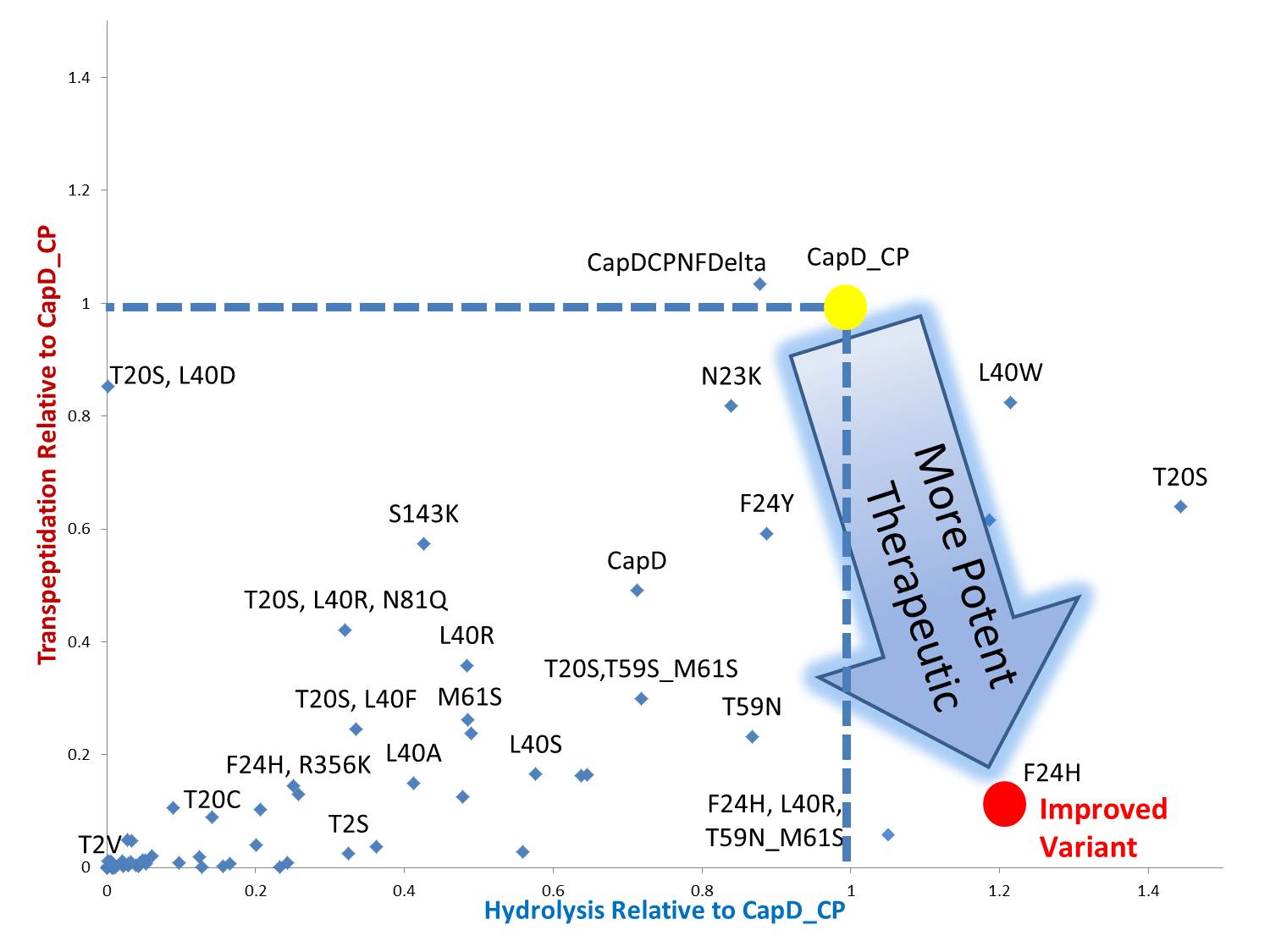Team:Washington/Gram Positive/Test
From 2010.igem.org
(→Catalytic Residue knock-outs show that capD_cp is catalyzing the reaction as expected) |
(→Catalytic Residue knock-outs show that capD_cp is catalyzing the reaction as expected) |
||
| Line 51: | Line 51: | ||
Before we could predict which mutations increase hydrolysis capability, we needed to validate that the circularly permuted version of CapD had measurable activity for further assessments. We also hypothesize a threonine residue in the catalytic site of CapD_CP plays an important role in the catalysis reaction and mutating it will eliminate all enzymatic activity. Thus using [https://2010.igem.org/Team:Washington/Project/Tools/FoldIt FoldIt ]we created two mutants, T2V and T2A, to act as negative controls and ran an [https://2010.igem.org/Team:Washington/Protocols/EnzymeAssayCapD enzyme assay] to confirm our hypothesis. The result shown in figure 3 (below) of this assay confirms our hypothesis that CapD_CP has enzymatic activity compared to the two catalytic knockouts. The relatively flat activity curves of the knockout mutants confirm the hypothesis of the threonine's role in the catalytic site. | Before we could predict which mutations increase hydrolysis capability, we needed to validate that the circularly permuted version of CapD had measurable activity for further assessments. We also hypothesize a threonine residue in the catalytic site of CapD_CP plays an important role in the catalysis reaction and mutating it will eliminate all enzymatic activity. Thus using [https://2010.igem.org/Team:Washington/Project/Tools/FoldIt FoldIt ]we created two mutants, T2V and T2A, to act as negative controls and ran an [https://2010.igem.org/Team:Washington/Protocols/EnzymeAssayCapD enzyme assay] to confirm our hypothesis. The result shown in figure 3 (below) of this assay confirms our hypothesis that CapD_CP has enzymatic activity compared to the two catalytic knockouts. The relatively flat activity curves of the knockout mutants confirm the hypothesis of the threonine's role in the catalytic site. | ||
| - | [[Image: | + | [[Image:Washington_Confirming_CP_activity_revised7.jpg|thumb|750px|left|Figure 3: Confirming the activity of CapD_CP by comparing it to two CapD_CP knockouts, T2A and T2V.]] |
<br style="clear: both" /> | <br style="clear: both" /> | ||
Revision as of 22:55, 10 October 2010
Contents |
Construction of CapD_CP
CapD_CP runs on a gel as one clean band
Depicted in Figure 1 is a gel comparing purified capD and capD_cp. This demonstrates one of the major advantages of CapD_CP, in addition to the fact that it is easy to express, it comes out in one clean band and is easy to quantify. CapD shows three bands, while the lower two bands are the expected pieces that occur after the enzyme undergoes self cleavage, the upper band is of unclear origin. Its mass corresponds to what would either be the unprocessed, inactive and monomeric form of the enzymes or the dimeric form that didn't denature. This ambiguity makes the amount of active CapD enzyme difficult to quantify.
CapD_CP is expressed at EXACTLY the correct molecular weight
In Figure 2 (below) we show the mass spec conformation of the molecular weight of CapD_CP. As expected, the N-terminal methionine is cleaved off by the native E. coli methionine aminopeptidase, resulting in a high level of pure active enzyme.
The circular permutation didn't result in a loss of activity
In the table 1 (below), we show the kinetic paramters for capD and capD_cp as determined using our enzyme assay. Due to the heterogenous mix of active (processed) and inactive (unprocessed) protein, the kcat is difficult to quantify. The data we obtained suggests that the kinetic parameters of capD and capD_CP are within error of each other. Therefore the circular permutation of capD did not have a negative effect on catalytic actiivty, suggesting that autoprocessing is not required for catalysis but simply a regulatory feature.
Catalytic Residue knock-outs show that capD_cp is catalyzing the reaction as expected
Before we could predict which mutations increase hydrolysis capability, we needed to validate that the circularly permuted version of CapD had measurable activity for further assessments. We also hypothesize a threonine residue in the catalytic site of CapD_CP plays an important role in the catalysis reaction and mutating it will eliminate all enzymatic activity. Thus using FoldIt we created two mutants, T2V and T2A, to act as negative controls and ran an enzyme assay to confirm our hypothesis. The result shown in figure 3 (below) of this assay confirms our hypothesis that CapD_CP has enzymatic activity compared to the two catalytic knockouts. The relatively flat activity curves of the knockout mutants confirm the hypothesis of the threonine's role in the catalytic site.
Designing CapD_CP to be a better Hydrolase
Screening Mutant Libraries
By standardizing the activity slope of each design relative to CapD_CP, a scatterplot easily portrays the qualities of each mutant. Several designs show negative catalytic curves similar to the catalytic knockouts. Some immediately show a negative activity curve meaning decrease in transpeptidation, hydrolysis, or both. T20S is a promising mutant hydrolase design.
Characterization of best hits
blah blah blah
 "
"





